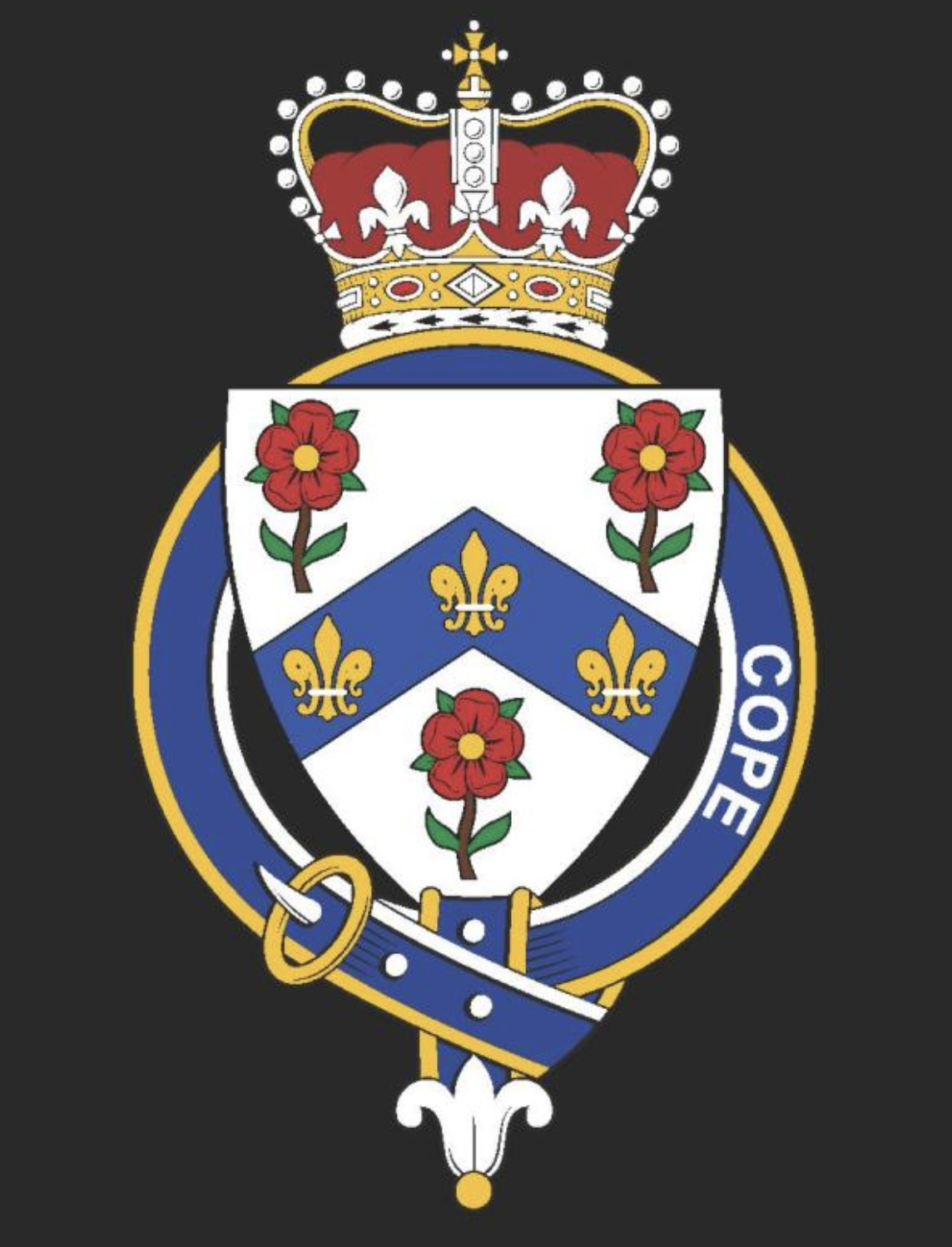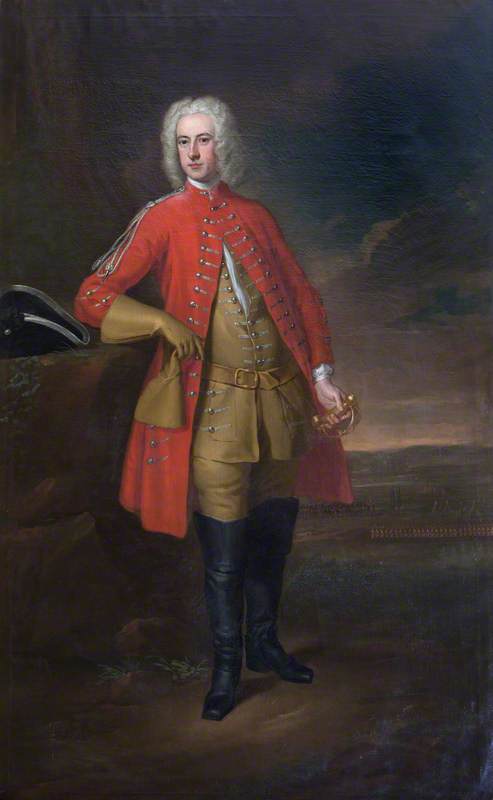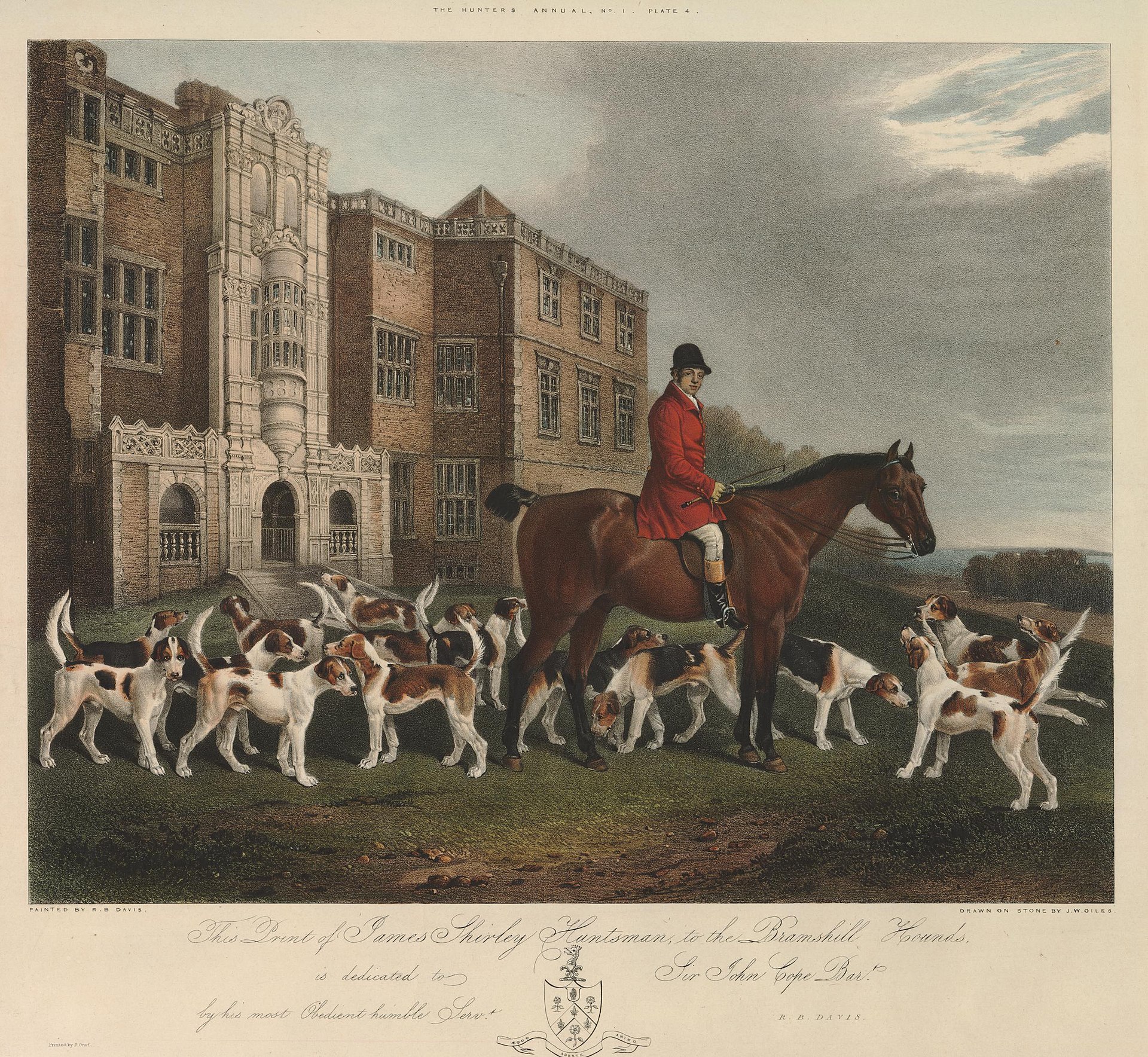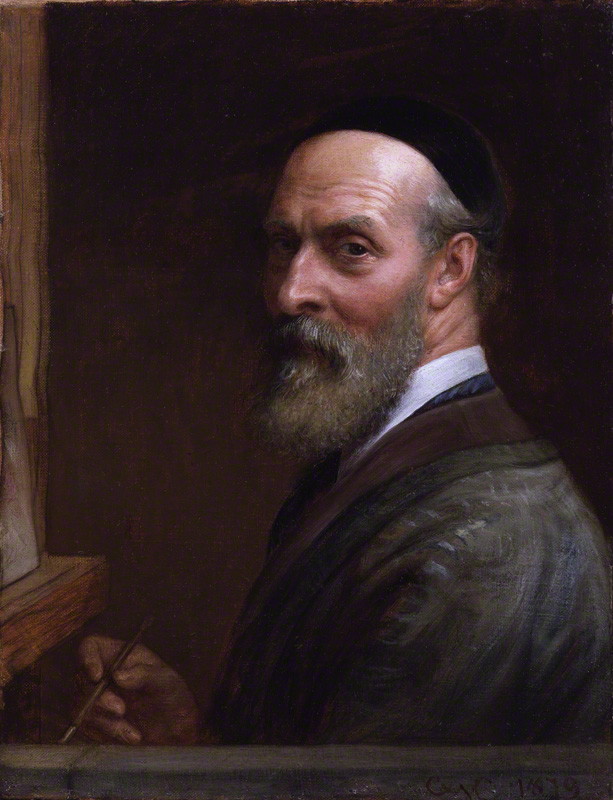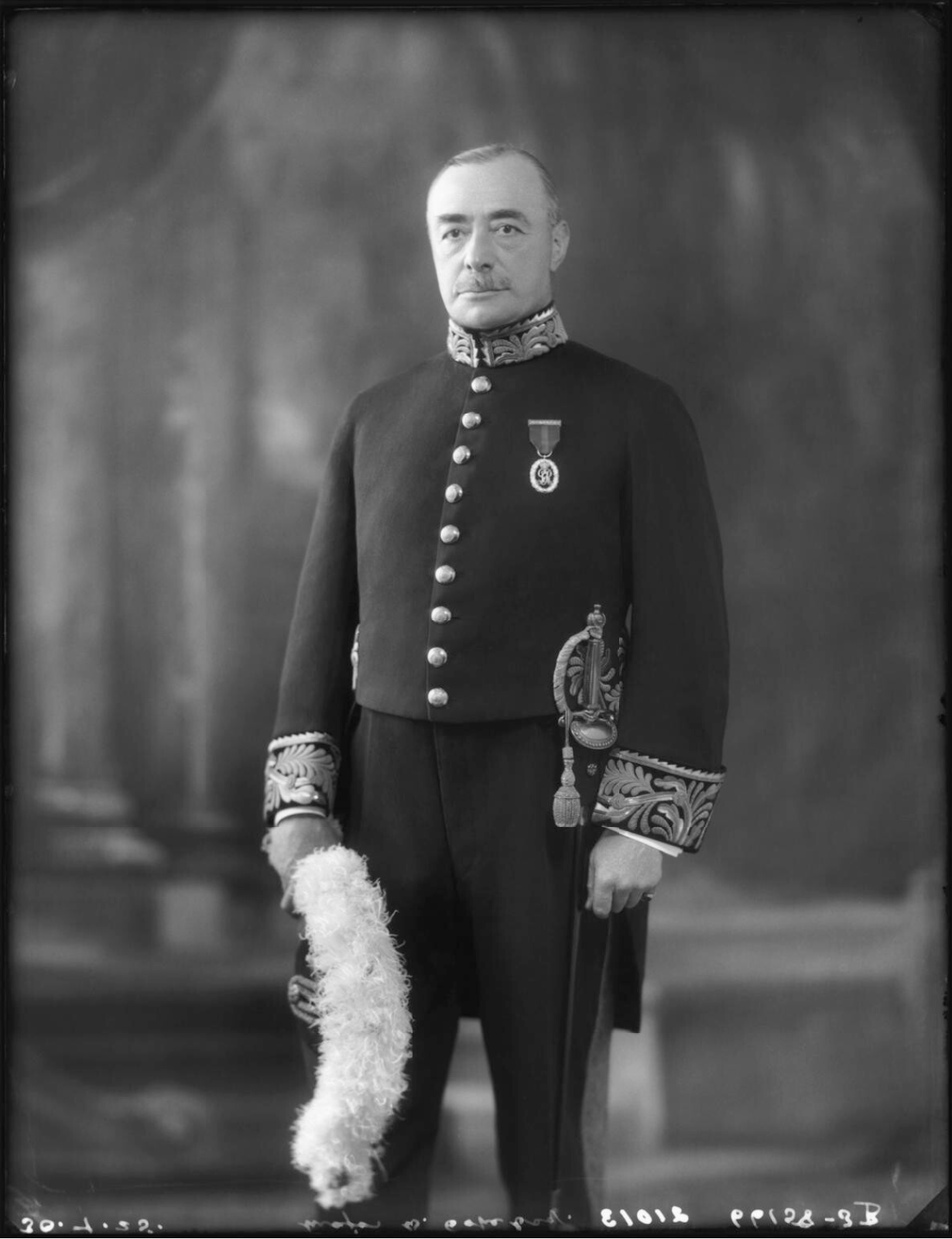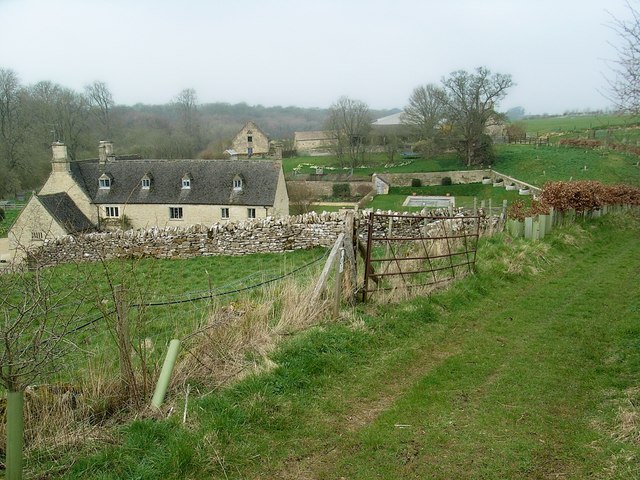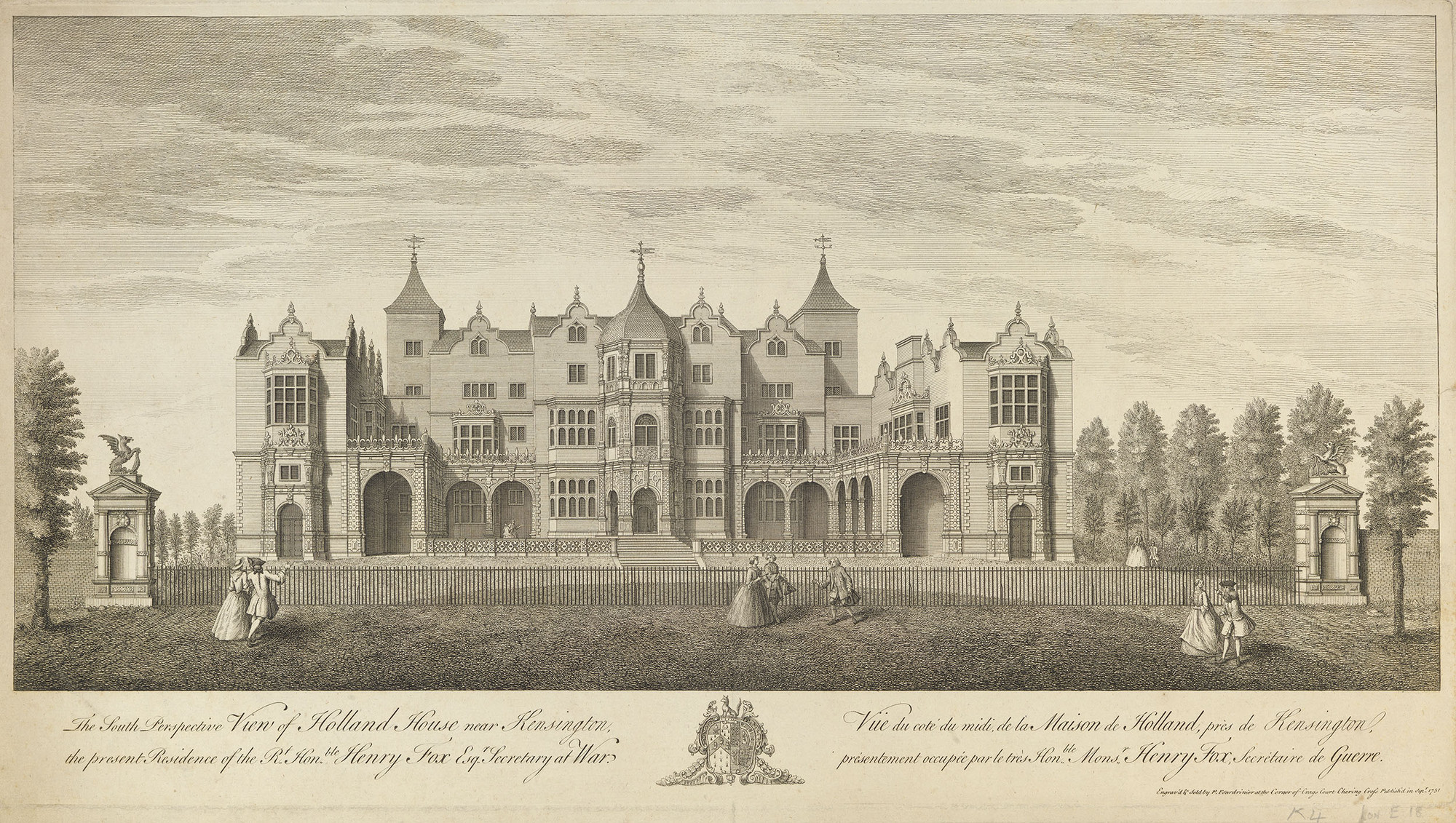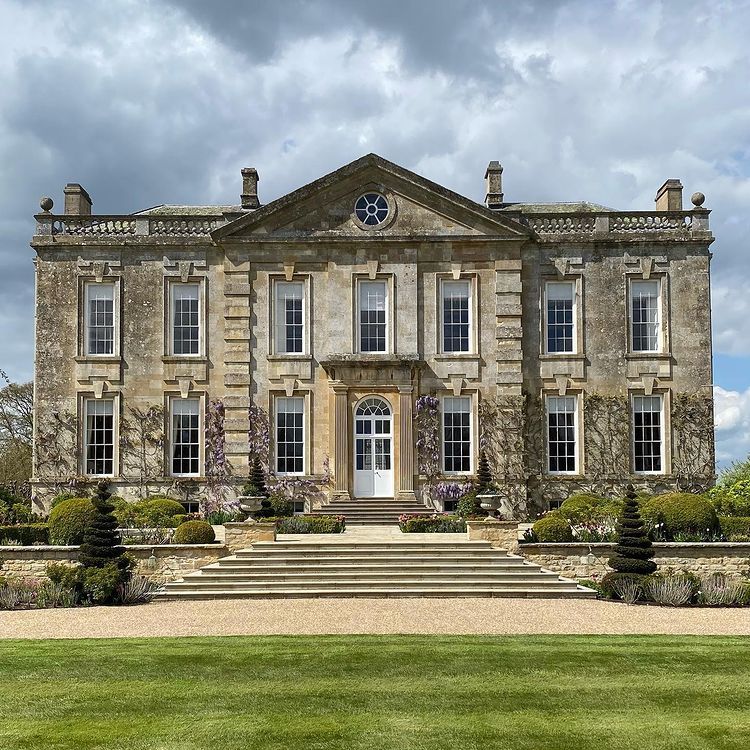House of Cope
Contents
- 1 Cope family
- 2 Background
- 3 Notable Family Members
- 4 Family Estates
- 5 Hanwell Castle in Oxfordshire - 1st Family Seat of Baronets of Hanwell
- 6 Tangley Hall and Farm in Oxfordshire
- 7 Campden House in Kensington, London
- 8 The Cope Castle (Holland House) in Kensington, London
- 9 Bruern Abbey in Oxfordshire - 1st Family Seat of Baronets of Bruern
- 10 Moreton Pinkney in West Northamptonshire
- 11 Bramshill House in Hampshire - 2nd Family Seat of Baronets of Hanwell
- 12 Dove Park Mansion House in Liverpool
- 13 References
Cope family
The House of Cope and Cope family is a noble and aristocratic English and British family of Barons and Baronets, originating from Banbury in Oxfordshire. Its members have served in various roles including Members of the Royal Household, Members of the Privy Council, Members of the House of Lords and Commons, diplomats, bankers, merchants, farmers, government officials, civil servants, academics, artists, and authors.
The Cope family began serving the Tudor monarchs King Henry VII, King Henry VIII, Queen Mary I, and Queen Elizabeth I, which helped them rise in prominence.
During the 16th and 17th centuries, the Cope family played a significant role in shaping the English economy and international trade. England's expansion in foreign trade occurred during this time as well.
The family motto in Latin is "Aequo - Adesto - Animo" (English: "Be present with an unchangeable mind").
Background
The Cope surname has its roots in the ancient Anglo-Saxon culture of Britain. It is believed that the name was given to someone who used to wear a long cloak or cape on a regular basis. The surname Cope is derived from the Old English word 'cope', which originated around 1225. This word comes from the Old English term 'cape' which means a cloak or cape.
The Cope family surname was initially discovered in Northamptonshire and Buckinghamshire. They were known to serve as civil servants during the reigns of Richard II and Henry IV and were rewarded with substantial land grants.
The Cope family can trace its earliest known members back to the time when England was ruled by the House of Lancaster. However, the family's rise to prominence occurred during the Tudor period when they began serving the King of England, first Henry VII and later Henry VIII.
John Cope of Deanshanger (died 1415) was the first prominent member of the Cope family. He served as a Member of Parliament for Northamptonshire in 1397. Another notable member of the family was Sir William Cope PC, who held the position of Cofferer of the Royal Household for King Henry VII of England and was also the Keeper of Porchester Castle.
Sir William was the son of Stephen Cope, grandson of William Cope, and great-grandson of John Cope, who was the MP for Northants. Sir William was married twice. His first wife was Agnes Harcourt, the daughter of Sir Robert Harcourt. Sir William's second wife was Jane Spencer, the daughter of Sir John Spencer of Hodnell. Sir William and Jane Spencer had several children together. Sir William sold the lordships of Wormleighton and Fenny Compton to the Spencer family, who later became the owners of Althorp.
Hanwell Castle, located in Banbury, Oxfordshire, served as the Cope family's primary residence for several centuries and has played host to English monarchs.
Construction work on Hanwell Castle started in 1498 under the direction of William Cope. Sir Anthony Cope later completed Hanwell Hall, which featured four towers and a gatehouse. Known as the "gallant house of Hanwell," it was a large quadrangular building with substantial towers at each corner.
Sir Walter Cope, a diplomat, commissioned the construction of Cope Castle in 1605, which was designed by architect John Thorpe. The castle was completed in 1607 and was later renamed Holland House after Sir Walter Cope's daughter, Isabel Cope, married Henry Rich, 1st Earl of Holland. Over time, Holland House became a popular meeting place for notable individuals, including Lord Byron, Charles-Maurice de Talleyrand-Périgord, Thomas Babington Macaulay, and Madame de Staël. Sadly, during World War II, Holland House was heavily bombed, and today, only the ruins of the house remain in Holland Park, Kensington, London.
Martha Hiden stated that Sir Walter Cope was one of the leading figures of his era in the creation and development of England's foreign trade. Cope was the owner of the Custom House Quay in the City of London and invested in new joint-stock companies, which played a significant role in pioneering England's international trade.
Sir Anthony Cope was knighted by Queen Elizabeth I of England and Ireland in 1590. He was also made the 1st Baronet of Hanwell by King James I of England, Ireland, and Scotland in 1611.
Notable Family Members
John Cope of Deanshanger MP (d. 1415), Member of Parliament for Northants
Sir William Cope PC (d. 1513), Keeper of the Porchester Castle, Constructor of Hanwell Castle, Cofferer of the Royal Household of King Henry VII, Member of the Privy Council
Sir Anthony Cope (1486-1551), Author, Sheriff of Oxfordshire and Berkshire, Vice-Chamberlain and Principal Chamberlain to Queen Consort and wife of King Henry VIII Catherine Parr
Dr Alan Cope (d. 1578), Author, Senior Proctor at the University of Oxford, Fellow at Magdalen College at the University of Oxford, Master of Arts, Native of the City of London
Sir Walter Cope MP (1553-1614), Constructor of the Cope Castle in London, Gentleman Usher of the Privy Chamber for King James I, Master of the Court of Wards, Chamberlain of the Exchequer, Registrar-General of Commerce, and Member of Parliament for Westminster
Sir Anthony Cope MP (1550-1615), 1st Baronet of Hanwell, Sheriff of Oxfordshire, Member of Parliament for Banbury and Oxfordshire
Sir William Cope MP (1577-1637), 2nd Baronet of Hanwell, Member of Parliament for Banbury and Oxfordshire, Sheriff of Oxfordshire, Member of Lincoln's Inn
Sir John Cope (1608-1638), 3rd Baronet of Hanwell
Sir Anthony Cope MP (1632-1675), 4th Baronet of Hanwell, Member of Parliament for Banbury and Oxfordshire
Sir John Cope MP (1634-1721), 5th Baronet of Hanwell, Member of Parliament for Banbury and Oxfordshire
Jonathan Cope MP (1664-1698), Tory Member of Parliament for Stafford, grandson of Sir William Cope, 2nd Baronet of Hanwell, Owner of the Cope family's Staffordshire estates, father of Sir Jonathan Cope, 1st Baronet of Bruern
Sir John Cope MP (1673-1749), 6th Baronet of Hanwell, Commissioner and Director of the Bank of England, Whigs Member of Parliament for Plympton Erle, Tavistock, Hampshire, and Lymington, Owner of Bramshill House in Hampshire
Sir John Cope KP MP (1688-1760) Whig MP for Queenborough and Liskeard, Governor of Limerick, Commander-in-Chief in Scotland, Lieutenant General
Sir Jonathan Cope MP (c. 1690-1765), 1st Baronet of Bruern (Brewerne), Tory Member of Parliament for Banbury, Owner of Hanwell Castle, Owner of the ground at the Custom House in the City of London
Sir Monoux Cope (1696-1763), 7th Baronet of Hanwell
Edward Cope Hopton MP (1708-1754), Tory MP for Hereford
Sir John Mordaunt Cope (1731-1779), 8th Baronet of Hanwell
Sir Richard Cope (1719-1806), 9th Baronet of Hanwell, Chaplain to the Speaker of the House of Commons
Sir Charles Cope (1743-1781), 2nd Baronet of Bruern (Brewerne), Sheriff of Cambridgeshire and Huntingdonshire
Sir Jonathan Cope (c. 1758-1821), 4th Baronet of Bruern (Brewerne)
Sir Denzil Cope (1766-1812), 10th Baronet of Hanwell
Sir John Cope (1768-1851), 11th Baronet of Hanwell
Sir Charles Cope (c. 1770-1781), 3rd Baronet of Bruern (Brewerne)
Charles West Cope RA (1811-1890), Victorian Era Painter, Professor of Painting, Academian at The Royal Academy of Arts in London, Silver Medal from the Royal Society of Arts, Manufactures and Commerce in London
Sir William Henry Cope (1811-1892), 12th Baronet of Hanwell, Rector of Easton, Author of Bramshill - Its History and Architecture (H.J. Infield, 1883)
Thomas Cope (1827-1884), Tobacco Manufacturer, Founder and Owner of Cope Bros & Co., Founding Member and the First Speaker of the Liverpool Parliamentary Debating Society
George Cope (1822–1888), Tobacco Manufacturer, Founder and Owner of Cope Bros & Co., Owner of the Dove Park (Reynolds Park) in Liverpool
Sir Thomas Cope (1840–1924), 1st Baronet of Osbaston
Sir Anthony Cope (1842-1932), 13th Baronet of Hanwell, Lieutenant colonel
Sir Arthur Stockdale Cope KVCO RA (1857-1940), Portraitist, Knight Commander of the Royal Victorian Order, Senior Royal Academian at the Royal Academy of Arts in London, son of Charles West Cope
Sir William Cope MP (1870-1946), 1st Baron Cope, Conservative Member of Parliament for Liandaff and Barry, The Comptroller of the Household, Master of Arts, Clare College, University of Cambridge
Sir Denzil Cope (1873-1940), 14th Baronet of Hanwell
Sir Thomas George Cope (1884–1966), 2nd Baronet of Osbaston
Sir Anthony Mohun Leckonby Cope (1927-1966), 15th Baronet of Hanwell
Dame Joan Penelope Cope (1926-1991), Author of Bramshill - Being the Memoirs of Joan Penelope Cope (1938), Daughter of Sir Denzil Cope, 14th Baronet of Hanwell, Lady Grant, Wife of Sir Duncan Alexander Grant, 13th Baronet of Dalvey
Sir Mordaunt Leckonby Cope (1878-1972), 16th Baronet of Hanwell
Lady May Isabel Blance Cope (1894-1970), Scholar
Lord John Cope MP, Baron Cope of Berkeley (1937-), Opposition Chief Whip of the House of Lords, Paymaster General, Treasurer of the Household, Conservative Member of Parliament for Northavon and South Gloucestershire, Member of the House of Lords
Family Estates
The Baronets of Hanwell initially resided at Hanwell Castle, but later moved to Bramshill House located in Hampshire. Meanwhile, the Baronets of Bruern (or Brewerne) continued to live at Hanwell Castle, Tangley Hall, and Bruern Abbey situated in Oxfordshire.
The Cope family owned lands in Notts, Derbys, and Essex, as well as in Hardwick, Hanwell, Drayton, Bruern, and Tangley.
Hanwell Castle in Oxfordshire - 1st Family Seat of Baronets of Hanwell
Hanwell Castle in Banbury, Oxfordshire was the seat of the Cope family for several centuries. It has hosted English Kings and Queens.
The construction work of the Hanwell Castle began in 1498 by William Cope. Sir Anthony Cope completed the Hanwell Hall. It had four towers and a gatehouse. The “gallant house of Hanwell”. It was a spacious quadrangular building, with massive towers at the angles.
King of England, Ireland, and Scotland James I made royal visits to the Hanwell Castle in 1606 and 1612. King James' visit was hosted by the 1st Baronet of Hanwell, Sir Anthony Cope. Sir Anthony created a beautiful garden for the estate.
King of England, Ireland, and Scotland Charles I visited Hanwell Castle in 1637. King Charles' visit was hosted by Sir William Cope, the 2nd Baronet of Hanwell.
Members of the Spencer family lived at the castle. Spencers were relatives.
Copes lived at Hanwell Castle until 1714 but the Copes owned it until 1781. 4th Baronet of Bruern, Sir Charles Cope was the last owner. The estate was in a good condition in the 19th century. During the late 19th century the estate gradually decayed.
Kellogg College, University of Oxford, has practised excavation at the estate. Hanwell Castle is a Grade II-listed building.
Many members of the Cope family are buried at St. Peter's Church in Oxfordshire.
Tangley Hall and Farm in Oxfordshire
Anthony Cope's son Edward Cope inherited Tangley Hall, Milton Under Wychwood, Chipping Norton, in 1551. Edward's son Sir Anthony Cope (b. 1548) inherited the estate.
Campden House in Kensington, London
Campden House was almost certainly the house in which Sir Walter Cope was living in 1598. Drawings by John Thorpe in Sir John Soane's Museum, however, Sir John Summerson identified two drawings - an elevation and a ground plan of a timber-framed house - with Campden House but maintained that they were much earlier than 1612. It now appears likely that these drawings (numbers 95 and 96 in Thorpe's book) were of the house which preceded Campden House and which may have been built for Cope towards the end of the sixteenth century.
Sir Walter Cope is reputed to have lost this land at a game of cards with Sir Baptist Hicks, 1st Viscount Campden.
A comparison of Thorpe's drawings with a painting showing Campden House shortly after the Restoration suggests that what took place in c. 1612 was perhaps an enlargement and refronting in brick and stone of the earlier house rather than a complete rebuilding.
Later Princess Anne, Prince George and their son William, Duke of Gloucester, took up residence here before she ascended the throne and moved to Kensington Palace.
The Cope Castle (Holland House) in Kensington, London
In the 1590s Sir Walter Cope began to purchase land in Kensington Sir Walter Cope started to build the Cope Castle in 1605 and finished in 1607. Architect John Thorpe designed the building. The Cope Castle became grander than Sir Walter Cope's previous home Campden House nearby.
Cope Castle was renamed Holland House because Sir Walter Cope's daughter Isabel Cope married Henry Rich, 1st Earl of Holland. During its history, Holland House became a salon for prominent figures. Lord Byron, Charles-Maurice de Talleyrand-Périgord, Thomas Babington Macaulay, and Madame de Staël dined at the house. Holland House was heavily bombed during WWII. The remains of the Holland House are in Holland Park.
Bruern Abbey in Oxfordshire - 1st Family Seat of Baronets of Bruern
Sir Anthony Cope bought the Bruern estate after 1610. The Bruern Abbey, a Baroque palace, in Oxfordshire was constructed for Sir John Cope (1688-1760) around the 1720s.
The architect of the Bruern Abbey is highly likely Oxford mason William Townsend. Townsend left his mark on Blenheim Palace, which is nearby. Blenheim Palace became the home of General John Churchill, the 1st Duke of Marlborough. Churchills and Spencers had a close connection to the Cope family.
Moreton Pinkney in West Northamptonshire
Sir Jonathan Cope, 4th Baronet of Bruern was the last member of the Cope family to own the Moreton Pinkney in West Northamptonshire. The estate was inherited by his wife's nephew, Edward Candler. Cope owned 387 acres (16 per cent) of Moreton Pinkey.
Currently, the manor belongs to Henry Oliver Charles FitzRoy (b. 1978), the 12th Duke of Grafton.
The manor house is ancient, bears the shields of the families of Cope and Gaudier, was restored and enlarged in 1860, and is approached through lodge gates bearing the arms of the Sempills.
Bramshill House in Hampshire - 2nd Family Seat of Baronets of Hanwell
One of England's great stately homes, Bramshill House was built on the site of an earlier property owned by Henry VIII, with King James and King Charles I keeping state apartments there in the early 17th century.
Bramshill House, a Jacobean mansion influenced by the Italian Renaissance, in Hampshire was bought by the 5th Baron of Hanwell, Sir John Cope in 1699. Bramshill House became the family seat of the Cope family. During the ownership of the Cope family, the landscape was shaped by the owners. Copes made several changes to the estate by modernising the property. The interior design was shaped by the Copes.
Author Charles Kingsley was the local rector and a regular visitor in the mid-1800s. Kingsley was hosted by the Cope family.
We have a potted history of the Cope family, as quoted in the Victorian County History of Hampshire, published in 1911. Under ‘Eversley’, we learn how the Cope family came to own Bramshill House, and how Bramshill came to be associated with fox-hunting. Sir John Cope, is well known as a master of foxhounds and owner of celebrated horses.
The Cope family sold the grand estate in 1936. Sir Denzil Cope (1873-1940), 14th Baronet of Hanwell, his wife Lady Edna Frances Cope (Hilton), and their daughter Dame Penelope Cope were the last Copes at Bramshill House.
Interior features include a great hall displaying 92 coats of arms on a Jacobean screen, an ornate drawing room, and a gallery 126½ feet long. Numerous columns and friezes are found throughout the mansion, while several rooms have large tapestries depicting historical figures and events on their panelled walls.
Bramshill House, near Basingstoke in Hampshire, is one of the largest and most important Grade I-listed Jacobean mansions in Britain. The grounds are a Registered Historic Park. They include 25 acres of early 17th-century formal gardens; a 490-acre medieval park re-landscaped from the 17th-20th centuries; 250 acres of woodland; and buildings such as an icehouse and a folly. Parts of the park have been used for commercial softwood production since the 19th century.
Dove Park Mansion House in Liverpool
Dove Park (currently Reynolds Park) was the home of George Cope, one of the wealthiest men in Britain, a tobacco manufacturer ('of Liverpool and London') who had bought it at auction in 1873 and whose widow sold it in 1907. It was the Cope family who had enlarged the original estate (and its house, on the site of the present-day sheltered housing complex, Calvert Court, Church Road) by acquiring an adjacent property which had its entrance in Woolton Hill Road.
References
Burke, Sir Bernard (1909). A Genealogical and Heraldic History of the Peerage and Baronetage, The Privy Council Knightage and Companionage. Pall Mall, London: Harrison & Sons.
^ a b "COPE, Sir William (1577-1637), of Hardwick, nr. Banbury, Oxon.; later of Hanwell, Oxon. | History of Parliament Online". www.historyofparliamentonline.org. Retrieved 2022-10-13.
^ a b c Burke, Bernard (1909). A Genealogical and Heraldic History of the Peerage and Baronetage, The Privy Council Knightage and Companionage. Harrison & Sons.
"COPE, Sir Anthony (1550-1614), of Hanwell, Oxon. | History of Parliament Online". www.historyofparliamentonline.org. Retrieved 2022-10-14. "William COPE of Grimsby and Hanwell (Sir Knight)". www.tudorplace.com.ar. Retrieved 2022-10-13.
Biddle-Cope, J.C. (1882). The Copes of Wiltshire. Worcester College, University of Oxford.
Burke, Bernard (1864). General Armory of England, Scotland, and Ireland. Harrison & Sons.
Burke, Bernard (1909). A Genealogical and Heraldic History of the Peerage and Baronetage, The Privy Council Knightage and Companionage. Pall, London: Harrison & Sons.
^ a b "CCHS talk - Excavations at Hanwell Castle". Chipping Campden History. Retrieved 2022-10-13.
^ a b "Holland House and its history | British History Online". www.british-history.ac.uk. Retrieved 2022-10-13.
Kelly, Linda (2015). Holland House: A History of London's Most Celebrated Salon. Norwich: I.B.Tauris.
"The library, Holland House, Kensington, London | Educational Images | Historic England". historicengland.org.uk. Retrieved 2022-10-13.
"Anthony COPE of Hanwell (1º Bt.)". www.tudorplace.com.ar. Retrieved 2022-10-14.
Burke, Bernard (1909). A Genealogical and Heraldic History of the Peerage and Baronetage, The Privy Council Knightage and Companionage. Pall Mall, London: Harrison & Sons.
Cokayne, George (1900). Complete Baronetage. Exeter: W. Pollard & co.
^ a b c "Hanwell Castle". www.polyolbion.org.uk. Retrieved 2022-10-13.
^ a b c d "Parishes: Hanwell | British History Online". www.british-history.ac.uk. Retrieved 2022-10-13.
"Hanwell Castle". www.polyolbion.org.uk. Retrieved 2022-10-13.
"Hanwell Castle". www.polyolbion.org.uk. Retrieved 2022-10-13.
"History". Hanwell Village. Retrieved 2022-10-13.
"The digging goes on: Fantastic finds and community engagement at Hanwell Castle dig". Kellogg College. Retrieved 2022-10-13.
"HANWELL CASTLE, Hanwell - 1287674 | Historic England". historicengland.org.uk. Retrieved 2022-10-13.
^ a b c DJPMedia (2018-06-25). "BRAMSHILL PARK". HOUSE AND HERITAGE. Retrieved 2022-10-13.
"Bramshill House - a grand Jacobean estate that became Police College". Bite-Sized Britain - Britain’s amazing history and culture. Retrieved 2022-10-13.
"BRAMSHILL HOUSE, Bramshill - 1340025 | Historic England". historicengland.org.uk. Retrieved 2022-10-13.
Foster, C. (2022, August 23). Bruern Abbey gardens Oxfordshire by Angel Collins. House & Garden. https://www.houseandgarden.co.uk/gallery/bruern-abbey
Stuff, G. (n.d.). Bruern Abbey, Bruern, Oxfordshire. British Listed Buildings. https://britishlistedbuildings.co.uk/101053360-bruern-abbey-bruern
Baldwin, J. (2018, July 26). Home From Home: Bruern Cottages, Cotswolds. The Arbuturian. https://www.arbuturian.com/travel/home-from-home-bruern-cottages-cotswolds
Townsend’s Tower at Blenheim Palace. (2015, October 21). https://www.geograph.org.uk/photo/1679048
Seventeenth-century Water Gardens and the Birth of Modern Scientific thought in Oxford. (n.d.). Google Books. https://books.google.fi/books?id=xa2ZEAAAQBAJ
Martha Hiden, ‘A Voyage of Fishing and Discovery, 1609’, The Virginia Magazine of History and 216 Biography, vol. 65, no. 1 (1957), p. 64.
Oxfordshire County Council, County Hall, New Road, Oxford, OX1 1ND; 01865 792422; [email protected]. (n.d.). Heritage Search - Oxfordshire County Council. https://apps2.oxfordshire.gov.uk/srvheritage/calmTree/selectNode?calmRef=E245
A Topographical Dictionary of England 1848
Cope Name Meaning, Family History, Family Crest & Coats of Arms. (n.d.). HouseOfNames. https://www.houseofnames.com/cope-family-crest
Shirley, Evelyn Philip, The Noble and Gentle Men of England; The Arms and Descents. Westminster: John Bower Nichols and Sons, 1866, Print.
Contributors to Wikimedia projects. (2020, December 28). Dictionary of National Biography, 1885-1900/Cope, Alan. Wikisource, the Free Online Library. https://en.wikisource.org/wiki/Dictionary_of_National_Biography,_1885-1900/Cope,_Alan
The History of Reynolds Park, Liverpool (continued). (n.d.). https://www.liverpool.ndo.co.uk/gatsoc/news20/page16.html
Joan Penelope (née Cope), Lady Grant - National Portrait Gallery. (n.d.). https://www.npg.org.uk/collections/search/person/mp90632/joan-penelope-nee-cope-lady-grant
Bramshill Being the Memoirs of Joan Penelope Cope: Amazon.co.uk: Cope, Joan Penelope: Books. (n.d.). https://www.amazon.co.uk/Bramshill-Being-Memoirs-Joan-Penelope/dp/B000O9L08S
Cooper, N. (n.d.). Holland House: Architecture in an Elite Society | Architectural History. Cambridge Core. https://www.cambridge.org/core/journals/architectural-history/article/abs/holland-house-architecture-in-an-elite-society/89A632BC3E1490454E68047007381DF9
Smith, R. (2020, August 6). Inside the sprawling stately home for sale that was once used by King James and Charles I. Hampshirelive. https://www.hampshirelive.news/news/hampshire-news/hook-bramshill-mansion-for-sale-4399747
Christie's, C. (n.d.). EDMUND HAVELL (BRITISH, 1785-1864). Christies.Com. Retrieved December 15, 2022, from https://onlineonly.christies.com/s/british-european-art/edmund-havell-british-1785-1864-159/156046
Hussain, D. (2019, March 29). Jacobean mansion used as apartments by King James then King Charles I on sale for £10 million. Mail Online. https://www.dailymail.co.uk/news/article-6864211/Jacobean-mansion-used-apartments-King-James-King-Charles-sale-10-million.html
The Great Houses of Kensington. (n.d.). https://www.rbkc.gov.uk/vmhistory/general/vm_hs_p03.asp
Barker, J. (2014, May 27). What was here before Kensington Palace? HRP Blogs. https://blog.hrp.org.uk/curators/what-was-here-before-kensington-palace/
The Pitt estate | British History Online. (n.d.). https://www.british-history.ac.uk/survey-london/vol37/pp49-57
COPE, Jonathan I (1664-94), of Ranton Abbey, Staffs. | History of Parliament Online. (n.d.). http://www.historyofparliamentonline.org/volume/1690-1715/member/cope-jonathan-i-1664-94
